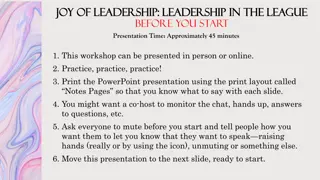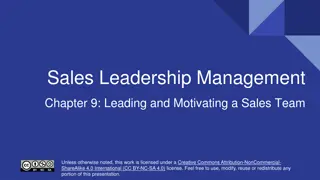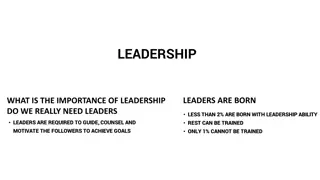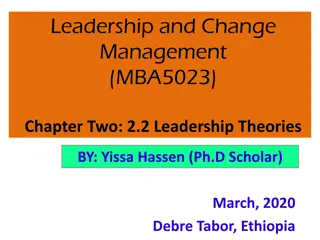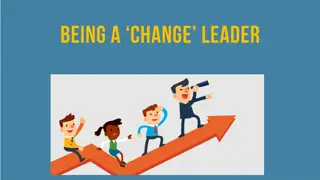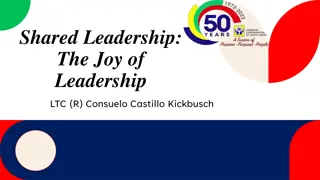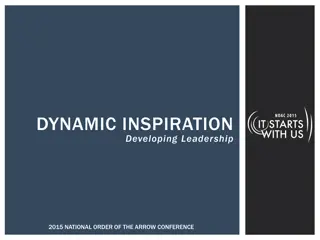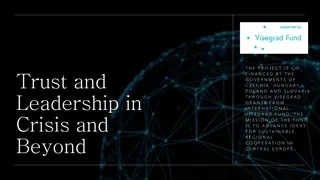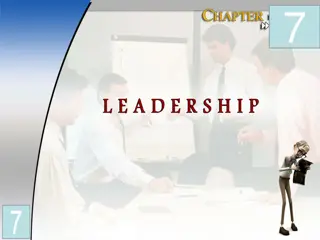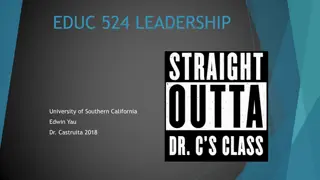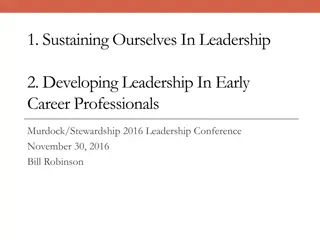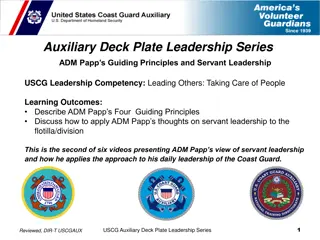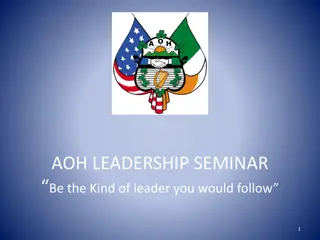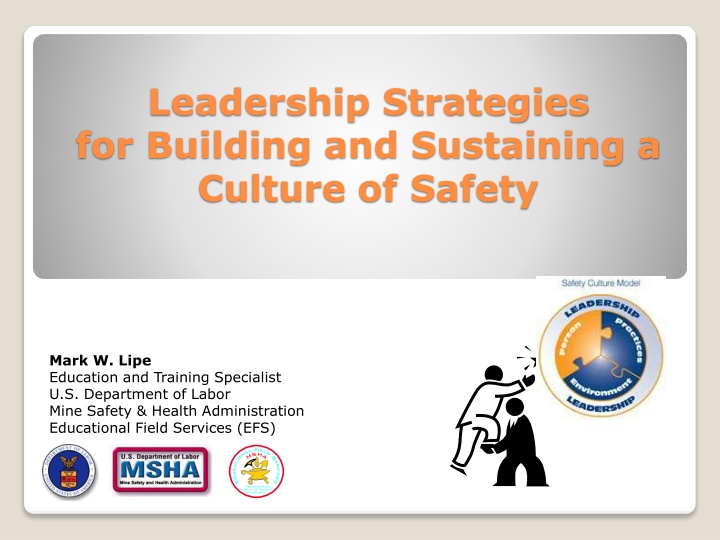
Strategies for Building a Strong Safety Culture in the Workplace
Explore common reasons safety initiatives fail and learn effective leadership strategies for creating and maintaining a positive safety culture. Discover why employee incentive programs may not lead to sustainable behavior change and the importance of moving from enforcement to fostering a safety culture.
Download Presentation

Please find below an Image/Link to download the presentation.
The content on the website is provided AS IS for your information and personal use only. It may not be sold, licensed, or shared on other websites without obtaining consent from the author. If you encounter any issues during the download, it is possible that the publisher has removed the file from their server.
You are allowed to download the files provided on this website for personal or commercial use, subject to the condition that they are used lawfully. All files are the property of their respective owners.
The content on the website is provided AS IS for your information and personal use only. It may not be sold, licensed, or shared on other websites without obtaining consent from the author.
E N D
Presentation Transcript
Leadership Strategies for Building and Sustaining a Culture of Safety Mark W. Lipe Education and Training Specialist U.S. Department of Labor Mine Safety & Health Administration Educational Field Services (EFS)
Discuss why many safety initiatives often fail to meet expectations Creating and sustaining a positive safety culture: Outlining a strategy Explore management and supervisory responsibilities Overview
How safety initiatives often look: Top level rhetoric about the importance of safety in site value hierarchy (i.e. versus production) Targeted training or canned courses presented as a reward or incentive System implementation Without attention to employee engagement! Not integral to job performance criteria Safety Initiatives
An employee-incentive program that provides knick-knacks for not getting hurt is based on the premise that the worker is the problem and that he or she can be motivated by awarding a prize. In the end, these programs typically yield short-term results despite their high cost. Safety Initiatives
Problem: Behavior change not sustained over time Participants of program change their behavior temporarily System implementation often marks a short term improvement on safety metrics followed by a return to previous levels, or System utilization ineffective Safety Initiatives
Practically all canned safety programs put the Safety Manager, And supervisors in the role of safety police! What happens when you have a safety enforcement environment rather than a safety culture? The futility of safety enforcement
Examining how organizations respond to change, initiatives and new programs requires understanding the dynamic curve of change . So, what am I to do? 7
The Dynamic Curve of Change Time Line Decline Phase All organizational programs, safety initiatives, etc., Have a defined life span Acceptance And Integration Phase Change Initiated Initial Acceptance Initial Resistance
The Dynamic Curve of Change Time Line Re-inventing / Re-Investing Team A cross-functional team that develops new ideas and or approaches to existing problems and or identifying elements which may be both known and unknown to the organization Decline Phase Acceptance And Integration Phase Change initiative must occur Prior to the decline phase! Why? Because in the decline phase, the Standard response is to cut Spending and programs. Change Initiated Initial Resistance Initial Acceptance
The Reality of Change in Organizations 5% 10% 80% 5% Percentage of Employee Engagement Explorers Pioneers Homesteaders Resistors & Saboteurs
The Champions for change Develop change and improvement momentum by building around the champions who are most likely to make the effort succeed. They will help to bring the others on board. They are also the ones you and everyone else can learn the most from.
Resistance Strategies Don't automatically label resistance to change as negative and something to be overcome or beaten back.
Resistance Strategies The real enemy of organizational change, is apathy. "Just tell me what you want done, boss, so I can get out of this place and on with my real life" is the attitude that kills change.
Resistance Strategies Resistors often have strong passion and high energy. They resist because they care. Understand the roots of their resistance and re- channel it. Get them inside the circle of wagons, shooting out.
Overcoming Internal Resistance So how do we manage that resistance? WIIFM Create a rally symbol DWP Inclusion not exclusion Open door management People don t care how much you know until they know how much you care!
Overcoming Internal Resistance Leadership . Has been defined in many ways. But the real definition is creating a vision others can see and realize. Effective leadership is about influence! And getting others to follow you willingly.
Overcoming Internal Resistance Developing effective leadership begins with . Give people something to believe in! Give people someone to believe in! Give people someone who believes in them!
Defining Organizational Culture Organizational learning, development and planned change cannot be understood without considering culture as the primary source of resistance to change. If leaders do not understand the cultures in which they are embedded, those cultures will manage them.
Defining an Organizations Culture Three Levels of Culture Artifacts Visual organizational structures and processed ( hard to decipher) Strategies, goals, philosophies (espouses justifications) Espoused Values Basic Underlying Assumptions Unconscious, taken for granted beliefs, perceptions, thoughts and feelings (ultimate source of values and actions)
Defining Organizational Culture Culture is: Norms of behavior reflecting the organization's practiced values
Organizational culture is comprised of all the stories told intentionally or incidentally by a collection of corporate storytellers. The origins of culture
The storytellers tell us what we "should" do; how we "should" do it as well as the "should not's" or taboos. The origins of culture
The origins of culture When the messages of cultural stories are ambiguous or conflict with one another, members are left to infer what values should guide behavior. As the members normalize on those values their own words and actions become corporate storytellers, communicating the values to others and further entrenching the corporate culture.
Defining Organizational Culture Simply stated, culture is: The way we do things around here
Safety Culture How then to create an enduring, positive safety culture? Requires a whole of system approach Requires changes to individual behavior and also those factors that influence and sustain individual behavior Requires total engagement of every manager and front-line supervisor!
Begins with hiring procedures Established through an engaging employee orientation program Style and effectiveness of safety meetings Style and effectiveness of safety training Quality and focus of inspections Rules and policies that are consistent and fair Quality of safety equipment Safety techniques and procedures BASIC SAFETY CULTURE
People dont respect what you dont inspect! BASIC SAFETY CULTURE
Leadership Strategies Define safety expectations in every job description Conduct Job Safety Analysis (JSA) and integrate them in the job Use safety as a measurable criteria in performance reviews Organize workplace safety audits and involve workers in the audit process Train first-line supervisors!
Leadership Strategies Actively engage a safety committee Investigate all accidents and near misses and conduct root cause analysis. Discuss findings with workers and supervisors. Use Visual Management techniques to re-enforce safe work practices and facilitate consistency.
The Leadership Role Successful leaders are prepared to set out in new directions - to find new opportunities and different ways to take things forward. Successful leaders begin with their people. They build a shared vision, then together determine what destination "success" should mean. Successful leaders find the new and look to the future. They don't rest in the past.
When people are highly motivated, its easy to accomplish the impossible. And when they are not, it s impossible to accomplish the easy

